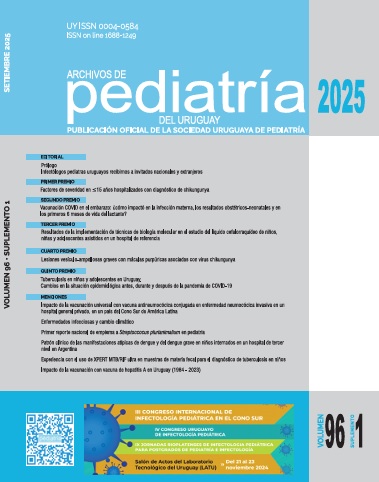Abstract
Introduction: in 2020, the World Health Organization (WHO) warned about the risk of neglecting tuberculosis (TB) control actions during the COVID-19 pandemic. In Uruguay, contingency guidelines for TB were defined, prioritizing the continuity of care for TB patients, contact tracing (especially children and immunocompromised individuals), and care for people in vulnerable situations. The global impact of the pandemic showed a decrease in diagnosed cases and an increase in TB mortality, which has been slowly reversing in the post-pandemic period.
Objectives: describe the epidemiological situation of tuberculosis in children and adolescents in Uruguay between 2018 and 2023. To determine if there were changes in the clinical presentation, bacteriological diagnosis, and lethality in three periods: before, during, and after the COVID-19 pandemic.
Methodology: descriptive, retrospective study of individuals under 20 years of age diagnosed with TB in Uruguay between 1/1/2018 and 31/12/2023. We analyzed the Data from the National Tuberculosis Registry Department: patronymics, clinical and bacteriological diagnosis, risk factors, and treatment evaluation. Three periods were compared: pre-pandemic (P1) TB cases from 2018-2019; pandemic (P2): years 2020-2021; and post-pandemic (P3): years 2022-2023. Descriptive statistics. Open Epi version 3.01.
Results: between 2018 and 2023, 660 children and adolescents were diagnosed with TB in Uruguay. 4% were under 1 year old and 50% were between 15 and 19 years old. 53% were male and 65% were residents of Montevideo. 71% of the cases were users of the public health provider, requiring hospitalization in 51%. Pulmonary location: 71% (bacteriologically confirmed 51%); extrapulmonary 17% (confirmed 40%); pulmonary + extrapulmonary 9%. Risk factors: History of contact with a TB case: 53%. TB/HIV coinfection 2%. Non-HIV immunosuppression 13%. Incarceration: 1.8%. Psychoactive substance use: 8%. Treatment evaluation - successful: 85%; loss to follow-up: 11%; deaths 13/660 - lethality 2%. Comparison of periods: Evolution of cases - P1: 176; P2: 212 (20.4% increase); P3: 272 (28.4% increase). There were differences in the clinical presentation, with a decrease in advanced forms. Bacteriological confirmation in pulmonary forms: P1: 54%; P2: 55%; P3: 47%. Treatment evaluation - successful: P1 90%; P2 82%; P3 84% (p 0.0082); loss to follow-up: P1 5%; P2 14%; P3 13% (p 0.0067); Lethality - P1: 1%; P2: 2%; P3: 3%.
Conclusions: the increase in cases of tuberculosis in children and adolescents has been sustained since 2018, with a significant rise in the post-pandemic period, as alerted by the WHO. Differences were identified in the forms of clinical presentation and location of the disease, with a decrease in advanced pulmonary forms. Treatment success declined during the pandemic, at the expense of higher losses to follow-up, with a slight recovery in the post-pandemic period. Lethality grew during and after the pandemic.

This work is licensed under a Creative Commons Attribution 4.0 International License.
Copyright (c) 2025 Archives of Pediatrics of Uruguay


